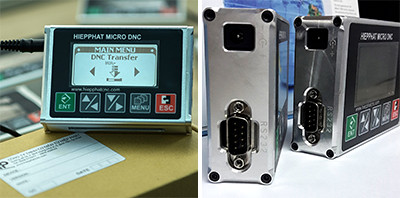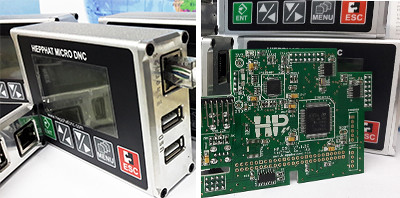What is DNC ?
The History of DNC:
During the pre-PC era of the 1960’s, machine tools operated using paper tape as a means of loading and running part programs. Many large companies owned the legendary “size of a city block” style mainframe computers and relied on them to communicate with their machine tools. Technological advances in all facets of manufacturing led the users of these computers to formulate ideas for running a wire directly from the mainframe to the machine tool. DNC, or Direct Numerical Control, was born of these initial attempts to create an uninterrupted avenue of communication between the computer and the machine tool. Throughout the late 1960’s and early 1970’s, fledgling DNC began to crop up in myriad homegrown varieties as manufacturers developed their own versions of the technology intended to take advantage of computer resources. Though the technology brimmed with potential, the absence of a DNC industry forced individual companies to wrestle with unreliable mainframes and under developed ideas.
The scarcity of well-defined DNC processes meant that each machine tool had to be individually addressed. Learning to speak the language of different machine tools was a time consuming process, and created the need for an industry leader with communication engineering already in place. By the time the PC exploded into existence. Over time, PC’s grew more powerful and could communicate in an entire network of machine tools. As technology improved, DNC, adopted Distributed Numerical Control, as the industry moved towards using PC’s in distributed processing.
Information on Wikipedia about DNC:
Direct numerical control (DNC), also known as distributed numerical control (also DNC), is a common manufacturing term for networking CNC machine tools. On some CNC machine controllers, the available memory is too small to contain the machining program (for example machining complex surfaces), so in this case the program is stored in a separate computer and sent directly to the machine, one block at a time. If the computer is connected to a number of machines it can distribute programs to different machines as required. Usually, the manufacturer of the control provides suitable DNC software. However, if this provision is not possible, some software companies provide DNC applications that fulfill the purpose. DNC networking or DNC communication is always required when CAM programs are to run on some CNC machine control.
Wireless DNC is also used in place of hard-wired versions. Controls of this type are very widely used in industries with significant sheet metal fabrication, such as the automotive, appliance, and aerospace industries.
All You Should Know About DNC...
-
- What is DNC?
- For many people DNC means just having a data connection between a CNC control and a computer - nothing more. Today, we understand that DNC encompasses two different tasks:
- a safe data transfer between a computer and a CNC - in both directions
- a data management system for NC programs
-
- What is a safe data transfer?
- When the first NC machines came on the market, RS232 was the only standardized interface, and data transfer with this media was the only known method of cable-bound communication with computers. But RS232 has some annoying disadvantages:
- safe data transfer is limited to only 15 m/16 yards.
- there is no real data checking; consequently, possible data errors are not recognized
When data is transferred over standard networks, such as Ethernet or Token Ring, data integrity is guaranteed. The transfer protocol TCP/IP checks data and automatically corrects errors if any data is corrupted. This feature allows the transfer of data over almost any distance over the network or the Internet.Shop floors, unfortunately, are places with a lot of heavy electro-magnetic noise that can cause data loss on RS232 lines. When the control cannot recognize data errors, the result may be malfunction of the machine - and in the worst case - cause damages on the machine and tools. Only modern network technology insures 100% data integrity.
-
- What is the benefit of program management?
- Before we go further, think about how much capital you have invested in your NC programs! How many hours would you have to reinvest, in case you lost all or part of your programs? How much time have your machine operators spent in re-entering NC programs that had been changed, because the modified version was lost? How much productive time do you loose every day because your operators have to spend time running from PC to control, searching on the laptop computer or tape device for the actual version of a specific program, comparing old and new program versions, or checking data because of transmission interruptions?A modern, efficient data management system stores your NC programs according your needs and allows you to access them by:
- machine number
- customer number
- part number/design number
An efficient program management system also displays the operation and setup a program is for.Using the click of a mouse, you should be able to view or edit a program. Modified programs should be compared automatically with the original in order to show you the differences, thereby allowing you to decide which one to use in future. Programs should be stored according the machine or machine group they belong to. Access to programs of other machines should be prohibited.
-
- What kind of DNC systems are on the market?
- Today, there are three groups of DNC systems for machines with serial interface on the market:
RS232-based DNC systems
These systems operate with a switch-box or multi-port interface card to connect multiple machines.- Advantages:
- low cost
- Disadvantages:
- many long cables;
- low level of transfer safety;
- slow transmission speed on distances > 15m/16yds.;
- mostly legacy software and outdated technology.
Terminal-based DNC Systems
To load programs, a CNC terminal is used. Other production data (order data, labor data, etc.) can be collected at the same time. Modern terminals also allow editing of NC programs. Today terminals are usually industrial PCs, and terminal systems are PC networks.- Advantages:
- MDC/PDC (machine data collection, production data collection) are optionally available. Full functionality of PCs professional systems usually equipped with a full complement of software.
- Disadvantages:
- usually expensive;
- often more functionality than operators need;
- long pay back period.
Network-based DNC systems
Integration of CNC machines in a company's network (Intranet). Direct access to NC programs without terminals. Lean, efficient solution.- Advantages:
- Safe data transfer over any distance with highest speed supported by controls. Highly comfortable and easy to operate. Moderate costs, short pay back period. MDC possible with the same Network smart network adapters. Compatible with all operating systems on the market. Extendible to terminal solution. Also wireless LAN version available.
- Disadvantages:
- more expensive than RS-232 solution.
















